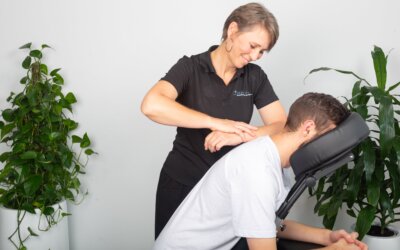
The 3-step guide to reduce pain and muscle tension at work
Just spent the last 10 hours working on a document that was due yesterday? You can feel your muscles in your neck pulling on your skull, resulting in a pounding headache and let’s not even talk about your shoulders feeling like concrete.
Muscle tension is a painful reality and a plague in most offices across the world. Our bodies were designed to be active in order to provide for our basic necessities such as food and shelter. Now with cars, elevators, wheelie office chairs, phones, chats, who needs to get up at all? Oh yeah, the poor coffee runner…
What is muscle tension and how does it affect me?
To better understand the problem we are facing, we need to have a look at what is going on in our bodies when we are forced to sit all day and work on the computer. So what is muscle tension and why does it cause us so much grieve? Simply put, muscle tension is a condition where our body’s muscles stay semi-contracted for extended periods. In other words, some of our muscles are working non-stop. No wonder we feel hard as brick! Our muscles are designed for specific jobs and range of motion. If a muscle is being over stretched constantly; for example our rhomboids (mid-back muscles), when we hunch over our computers, creating that burning pain between our scapulas, it also means that other muscles are shortened or contracted. If this contraction is prolonged, when the body comes back to a natural position, the muscles feel stiff and painful. Have you ever felt like your hips have trouble unfolding after sitting for who knows how long? So muscle tightness is painful, that’s a fact. The problem is, it can also cause other health problems such as: nerve entrapment, breathing restriction, digestive problems, extra pressure on joints and disks and even impact the shape of our skeletal system. The good news is that with proper awareness and exercise regimen, muscle tension can be controlled and pain, become a thing of the past.
3 Steps to help you reduce your muscle tension
1) Quick fix ergonomics
The first step to take in order to improve our muscles health is to examine our workplace ergonomics. A few simple adjustments we can make to help our posture are:
-Position computer screens at eye levels and centered to avoid hunching and excessive head turning.
-Chair level should allow elbows to be at 90 degrees insuring shoulders are straight.
-Hips should be slightly higher then 90 degrees to avoid increased pressure on bottom and spine.
-Back should be fully supported with natural curvature.
-Feet should be flat on the floor, otherwise, use a footrest.
2) Get to know your body
The second step is about awareness. The most powerful tool in fixing your posture is yourself. Our bodies always send us different messages, like pain and thirst, so we know we need to take action. Pain is not something you have to live with and investigating the cause is vital to implement appropriate changes. This could be as simple as changing your pillow or adjusting your work chair’s height. But sometimes, consulting your health professional is necessary. They can investigate with questions and movement testing, to help determine the real cause of your pain and help you by providing the tools you need to work on eliminating the pain. It is important to remember that pain is not something you have to live with, but you have to listen and take action in order to have a healthy, pain free body.
3) Take a break, move around
We have heard it a million times: sitting is our enemy. So the third step is to battle it out and force yourself to take a break every hour. During this time, take 5 minutes to stretch these 4 muscle groups:
-Neck (Maintaining your shoulders straight, bring your head to the side with the hand on the opposite side. Then, bring your head to a diagonal position, looking towards the ground and gently pull head downwardly.)
-Chest (Bring your arm backwards until it forms a 90-degree angle with your back. Grab hold of a wall and push on your arm until you feel your chest open up and stretched out.
-Hips (Bring one foot to your butt, pulling up until you feel your quads and hips stretching.)
-Butt (Sitting on your chair, bring one foot to the opposite knee and gently bring down until you feel a good stretch in your butt.)
Maintaining a healthy muscle tone is not an easy task with our lifestyle today. The good news is there are tons of ways you can make a difference on your body and feel better. Start with these 3 tips until you create a comfortable routine and you will notice a difference.
Please share if you feel this can help anyone with their health at work. Tell us your tips so we can all learn and improve our health at work!
More Articles
4 Executive Christmas Gift Ideas for a Month of Cheer And Motivation
The holiday season is upon us, and what better way to spread cheer in your office than with thoughtful and unique Christmas gifts for your key staff? At Healthify, we believe in promoting overall workplace wellbeing. Here we have created a weekly advent calendar style...
5 Activities to Include in a Workplace Wellbeing Plan
In today's fast-paced work environment, taking care of employee wellbeing is paramount for businesses looking to enhance productivity, reduce turnover, and foster a positive work culture. A well thought out workplace wellbeing plan can significantly contribute to...
The Importance Of Workplace Wellbeing
Even before Covid-19, workplace wellbeing had gained increasing attention for its significant impact on employee happiness and productivity. While wellness was once primarily associated with physical health, it is now widely recognised that mental well-being is...
Why Do We Use A Massage Chair in the Workplace?
In today's fast-paced corporate environment, prioritising employee wellbeing has become increasingly important. As a result, many companies are exploring innovative ways to promote wellness and reduce stress levels. It is important when choosing workplace wellbeing...
Elevating Team Morale: Workplace Massage Sessions for Enhanced Collaboration and Bonding
When it comes to building a strong and cohesive team, traditional team-building activities may not always hit the mark. In search of unique and effective strategies, organisations are turning to workplace massage sessions as a powerful tool for enhancing collaboration...
The Role of Workplace Wellness Programs in Employee Retention and Engagement
In today's competitive job market, attracting and retaining top talent has become a priority for organisations. One effective strategy that businesses are adopting is the implementation of workplace wellness programs. These programs, which often include services such...
Learn more about what Healthify can do for your team





